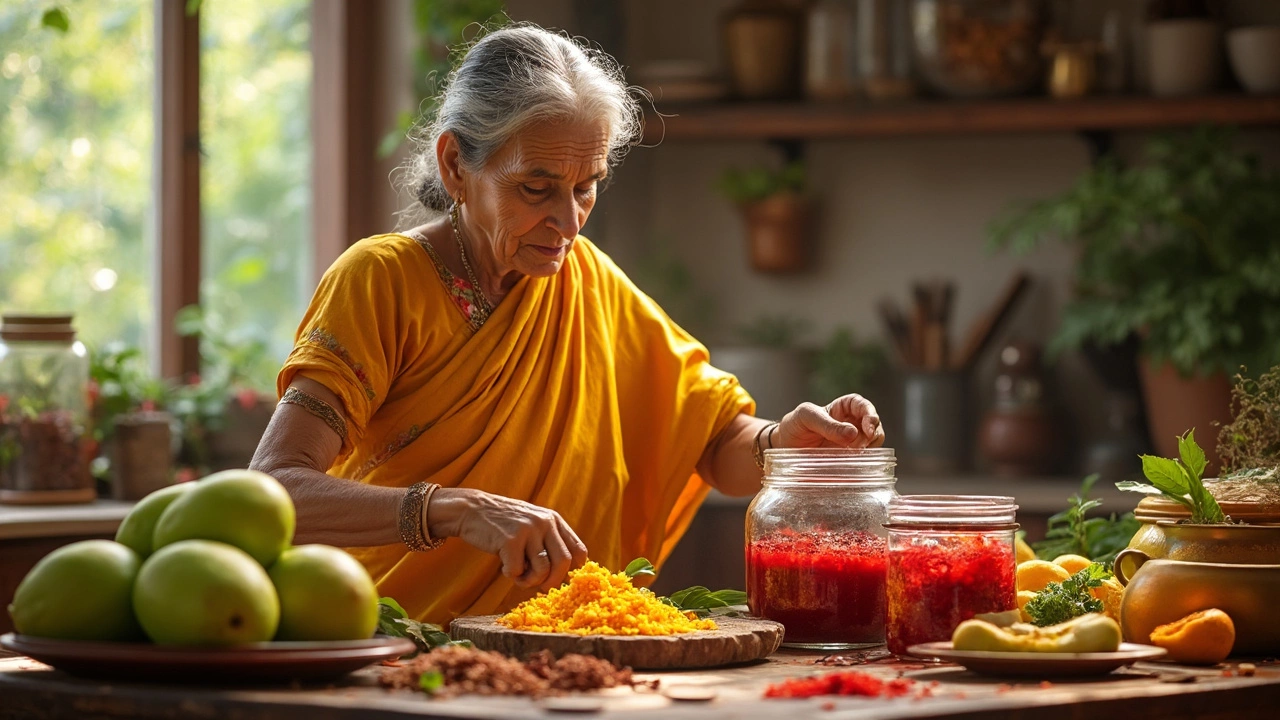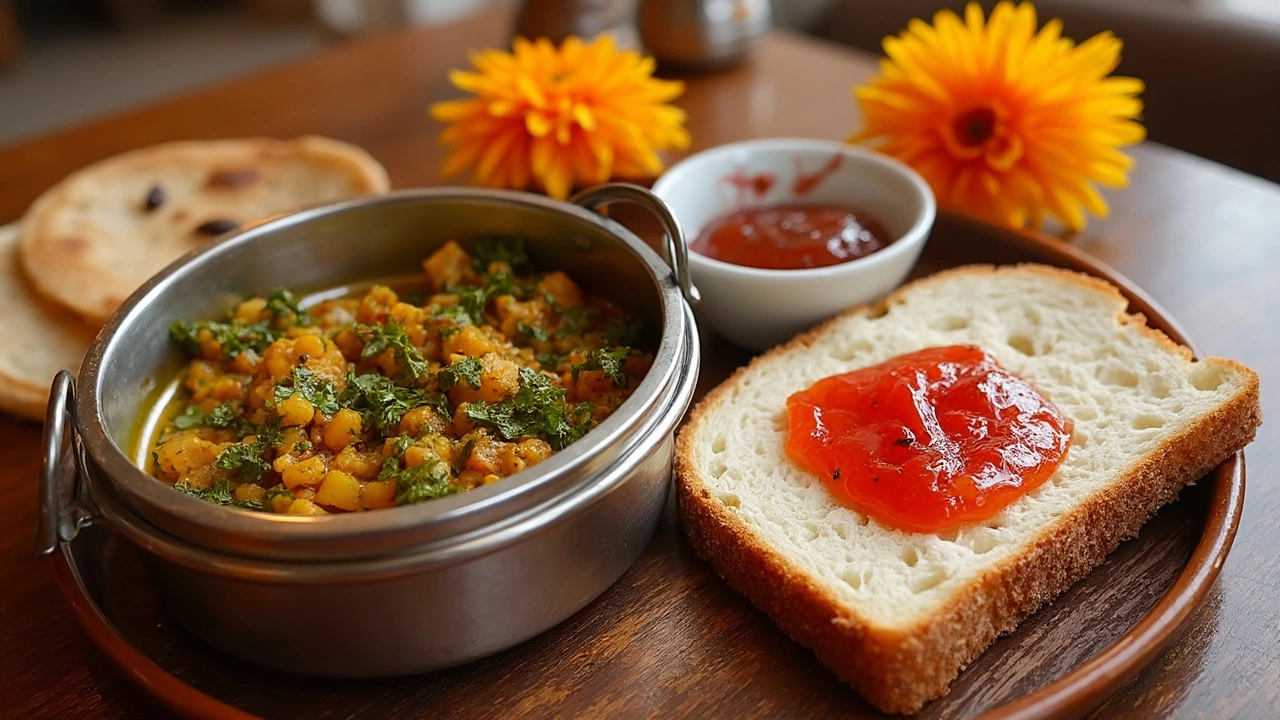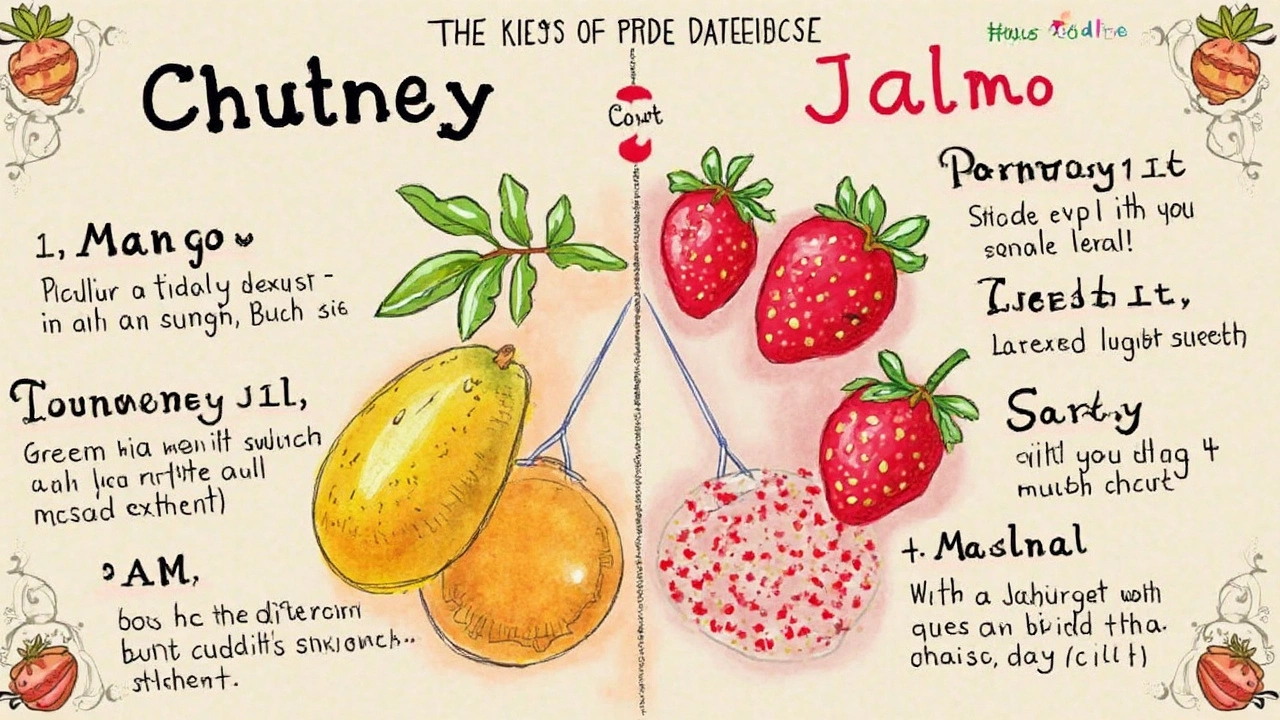Chutney vs Jam: How They Differ and Why It Matters
 May, 14 2025
May, 14 2025
Ever spread something tangy on toast and wondered—wait, is this chutney or jam? It’s a common mix-up, but the differences are clear once you know what to look for.
Chutney packs a punch with its mix of spices, vinegar, and a balance between sweet and spicy. Jam, on the other hand, is all about fruit and sweetness—more like a hug for your taste buds than a slap. If you’ve grabbed a jar and found chunky bits, a bold tang, or even some heat, you’re most likely dealing with chutney. Smooth, sticky, and sugary? That’s jam’s territory.
Don’t just use these as toast toppers. Chutneys love to hang out with cheese boards, grilled meats, and even stir-fries. Jam excels at breakfast but doesn’t complain if you dollop it in yogurt or desserts. If you ever try making them at home, you’ll immediately notice chutney takes patience, spices, and a nose for flavor combos, while jam is all about capturing fruit at its sweetest moment.
- What Is Chutney?
- What Is Jam?
- Key Differences Explained
- Tips for Making Each at Home
- When to Use Chutney vs Jam
What Is Chutney?
Chutney is a type of spread or condiment that started in India but now shows up in kitchens all over the world. It comes in many flavors and levels of chunkiness, but the classic vibe is bold—think sweet, tangy, spicy, and sometimes even a bit sour, all rolled into one spoonful. The magic of chutney is how it brings together fruits or veggies, spices, vinegar, and sugar, with each batch having its own twist depending on what’s in season or what’s hanging around in your pantry.
Unlike jam, which focuses on preserving fruit’s natural sweetness, chutneys are more about balancing flavors. They often use ingredients like mango, apple, tomato, or onion, mixed with chili, ginger, garlic, and a hit of vinegar for that signature tang. Some chutneys are cooked for hours until they’re thick and rich; others stay fresh and crisp, just mixed and chilled.
Here’s what usually goes in a classic chutney:
- Fruit or vegetables (like mango, apple, tomato, onion)
- Vinegar (for tang and as a preservative)
- Sugar (for sweetness and thickening)
- Spices and seasonings (mustard seeds, cumin, chili flakes, ginger, garlic)
Chutney isn’t just for fancy Indian feasts—try it on grilled cheese, next to roasted meats, or as a zesty dip. And fun fact: properly made chutney can last up to a year in a sealed jar, thanks to all that vinegar and sugar keeping bad stuff out.
To give you a quick peek at how chutney compares to similar spreads, check out this table:
| Feature | Chutney | Jam |
|---|---|---|
| Main Ingredients | Fruit/veggies, vinegar, sugar, spices | Fruit, sugar, pectin |
| Texture | Chunky/smooth, often with visible pieces | Smooth or slightly chunky |
| Flavors | Sweet, spicy, tangy, savory | Sweet, fruity |
| Origin | India | Europe |
| Shelf Life (sealed) | Up to 12 months | Up to 12 months |
So, why does knowing about chutney matter? If you want to unlock new flavors in your kitchen or up your dinner game, grabbing a jar of chutney is a no-brainer. It’s way more versatile than people think—trust me, even Max wags his tail when he sniffs it simmering on the stove!
What Is Jam?
Jam is what most of us grew up smearing on toast or swirling into yogurt. At its core, jam is made by cooking fruit with sugar until it turns thick and spreadable. It’s all about that fruity sweetness, locking in the flavor so it can last for months.
Most jams use just a handful of ingredients: fruit, sugar, and sometimes a bit of lemon juice or pectin. Pectin is that magic helper—it’s a natural fiber found in fruit that makes the mixture set and gives jam its signature gel-like texture. While all fruits have some pectin, things like apples and citrus pack the most, which is why some jams thicken faster than others.
Jams are different from jellies and preserves. Jellies use just the fruit juice, making them super smooth. Preserves often keep bigger pieces of fruit. Jam lands right in the middle, with soft fruit bits suspended in syrupy goodness.
Here’s a fun fact: In the U.S., for a spread to legally be called "jam," at least 45% of the mixture must be fruit. No skimping!
| Common Jam Fruits | Pectin Content |
|---|---|
| Strawberries | Low |
| Apples | High |
| Blueberries | Medium |
| Grapes | Low |
| Oranges | High |
Why bother with jam? Well, it’s super versatile. Even beyond the classic PB&J, you can dollop jam on pancakes, swirl it into rice pudding, or mix it into salad dressings for extra punch.
- Tip: For the brightest flavor, make jam with in-season, ripe fruit.
- If your homemade jam isn’t setting, try adding a little more lemon juice—it boosts the pectin.
If you’re after that sweet fruit flavor and easy shelf life, jam is the go-to option.

Key Differences Explained
The main split between chutney and jam? It’s all about their base ingredients, flavor profile, how you cook them, and what you use them for. Here’s how they stack up:
- Chutney uses fruit or veggies, along with vinegar, sugar, and a hefty mix of spices. Think ginger, mustard seeds, chili flakes, sometimes even garlic or onion.
- Jam keeps it simple: mostly fruit and sugar, sometimes a bit of lemon juice or pectin for thickening. Spices rarely come to the party.
If you’re after something that kicks, go for chutney. It balances sweet, sour, salty, and spicy all at once. Jam, on the other hand, is about capturing fruit flavor and making it sweet and spreadable. No heat, no tart bite—just fruity goodness.
Consistency also sets them apart. Chutney is chunky—it might even look rustic, with visible pieces of fruit or veggie. Jam is smooth or only slightly textured, often jewel-like and uniform.
| Chutney | Jam | |
|---|---|---|
| Main Ingredients | Fruit/veg, vinegar, sugar, spices | Fruit, sugar, pectin |
| Taste | Tangy, sweet, spicy, slightly salty | Sweet, fruity |
| Texture | Chunky, saucy | Smooth, thick, spreadable |
| Preservation | Relies on vinegar and sugar | Relies on sugar and pectin |
| Typical Use | With meats, cheese, savory foods | On toast, pastries, breakfast foods |
Now, check this out: the average sugar content in jam is over 60%, while chutney usually sits closer to 30–40%, thanks to the vinegar and spices. Shelf life, though? Chutney will often beat jam, especially the kinds with loads of vinegar. Some homemade chutneys last up to a year or more if you keep them in the fridge.
So next time you’re standing in front of the fridge, wondering what goes best with your cheddar, remember: jam is for sweetness, chutney is for flavor fireworks. Both have their place, but knowing the difference gets you tasting the right thing at the right time. And if you’re making either at home, it pays to respect the process—jam is quick, chutney is slow and low.
Tips for Making Each at Home
If you’ve ever thought about whipping up your own chutney or jam, it’s easier than it looks. The trick is knowing what makes each one click. Chutney goes bold with spices and a sharp bite, while jam keeps it simple and sweet.
Start with chutney. Choose sturdy fruits or veggies—think mango, apple, tomato, or even onion. Load up on vinegar, sugar, and your favorite mix of spices like ginger, cumin, mustard seeds, and chili flakes. The balance of tang, sweetness, and spice is what makes chutney sing. Always chop ingredients small so flavors meld as it simmers.
- Stick to the 1:1:1 formula—equal parts fruit/veg, sugar, and vinegar for classic chutneys.
- Cook low and slow, stirring often to keep it from sticking.
- Don’t skip sterilizing your jars—this keeps your chutney shelf-stable for months.
- Taste as you go. Too sharp? Add sugar. Too sweet? A splash more vinegar.
With jam, it’s all about the fruit. Pick ripe, juicy stuff—strawberries, raspberries, or whatever’s in season. Chop it up, toss with sugar, and squeeze in some lemon juice. The fruit’s own pectin (or some added if needed) helps it set.
- Use a 2:1 fruit-to-sugar ratio for most jams—this keeps it spreadable, not runny.
- Bring to a rapid boil and skim off any foam for a clear, glossy result.
- Lemon juice helps the jam set and pumps up the flavor.
- Test the set by dropping a spoonful on a cold plate; if it wrinkles, it’s ready.
Here’s a quick look at how they stack up side-by-side:
| Chutney | Jam | |
|---|---|---|
| Main Ingredients | Fruit/veg, vinegar, spices, sugar | Fruit, sugar, lemon juice/pectin |
| Typical Cooking Time | 45–90 minutes | 15–30 minutes |
| Texture | Chunky, saucy, sometimes thick | Smooth, spreadable |
| Flavor | Sour, sweet, spicy, tangy | Mostly sweet, sometimes a hint of tartness |
| Best Use | Savory foods, cheese, meats | Toast, pastries, desserts |
If you’re just starting, don’t stress over perfection. The fun’s in experimenting. Some folks even toss in extra apples to get chutney to thicken (apples have loads of pectin, like a natural helper). For jam, a sugar thermometer helps you hit the right temperature—around 104°C (219°F) is the sweet spot for setting.
Homemade means you control the sugar, spice, and everything else. Once you nail your first batch, you won’t go back to store-bought.

When to Use Chutney vs Jam
Picking between chutney and jam honestly comes down to what you’re eating and what taste you’re after. Chutney is the go-to when you want to add some kick, tang, or complexity to savory dishes. Jam is your best friend if you want pure, simple fruit sweetness.
Here’s where most folks reach for one or the other:
- Chutney is awesome with cheese platters, roast meats, and even burgers. It’s not rare to spot chutney paired with samosas, curries, or as a topping for grilled veggies. If you want to turn up the flavor of anything salty, creamy, or meaty, chutney’s your answer.
- Jam rules breakfast—spread on toast, bagels, or croissants. You’ll see it in PB&J sandwiches, swirled into oatmeal, or as cake fillings. Jam is pure comfort food when you need something sweet and familiar.
Let’s look at how they stack up in popular uses:
| Use Case | Chutney | Jam |
|---|---|---|
| Snack Boards | Perfect with cheese, crackers, cured meats | Sometimes paired with mild cheeses |
| Sandwiches | Great on grilled cheese, roast beef, or turkey | Classic with peanut butter, on breakfast sandwiches |
| Breakfast | Good with eggs or hash browns for a twist | The star for toast, pancakes, or scones |
| Desserts | Surprisingly good with vanilla ice cream or cakes | Famous for tarts, pastries, and cake layers |
| Main Meals | Side for curries, roast chicken, barbecue | Rarely used, except for glazes or sauces |
If you’re hosting dinner and want something to wake up your guests’ taste buds, go for a strong chutney. But if you’re making a quick breakfast for the kids or filling pastries, jam will save the day. Max, my dog, gets way more excited about a roast with apple chutney on my plate than he does about toast with jam—probably because he’s hoping for a roast bite. There’s a reason chutney shows up in flavorful recipes while jam keeps it simple in the sweet lane. Pick what matches your meal and the vibe you’re going for!
